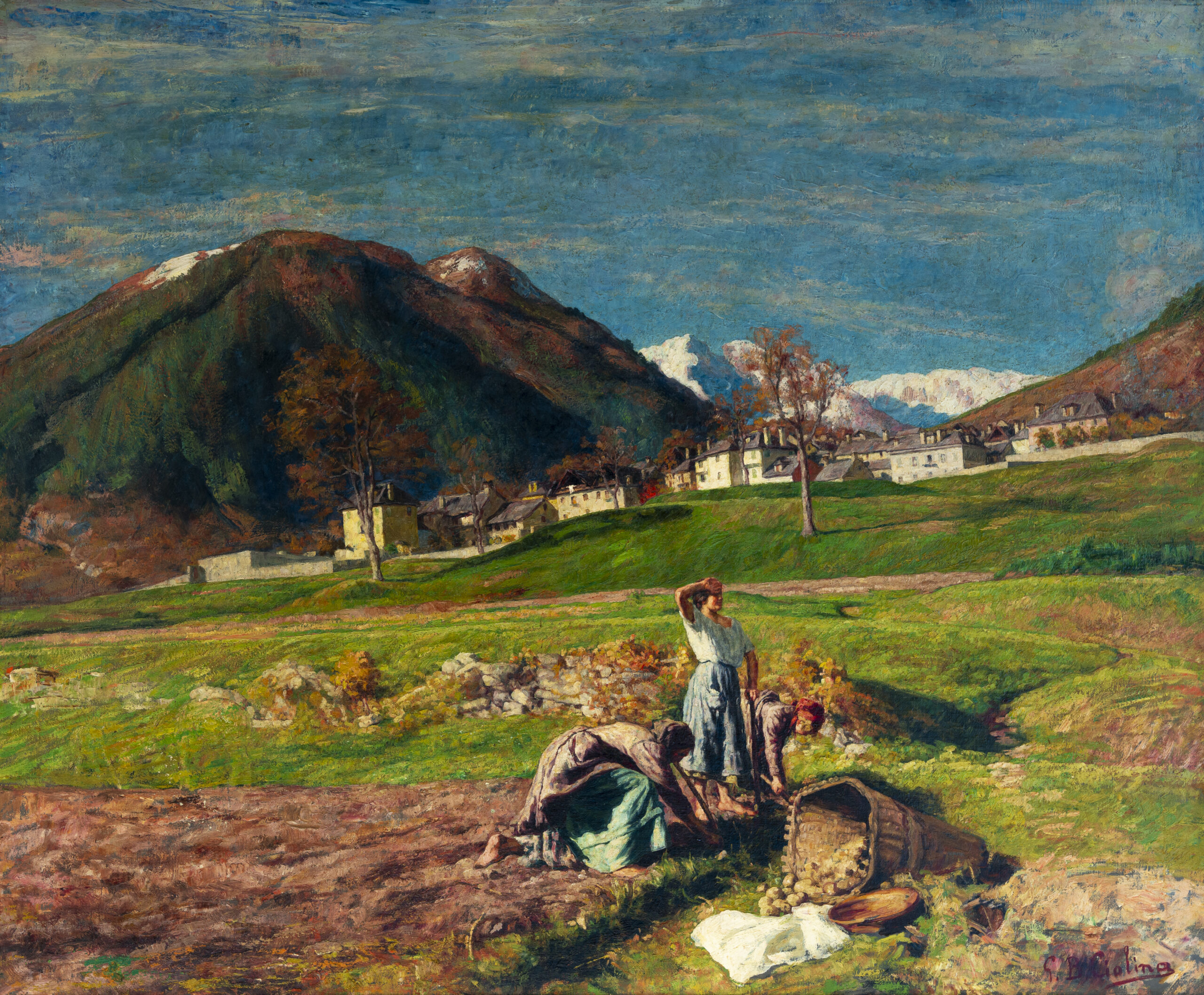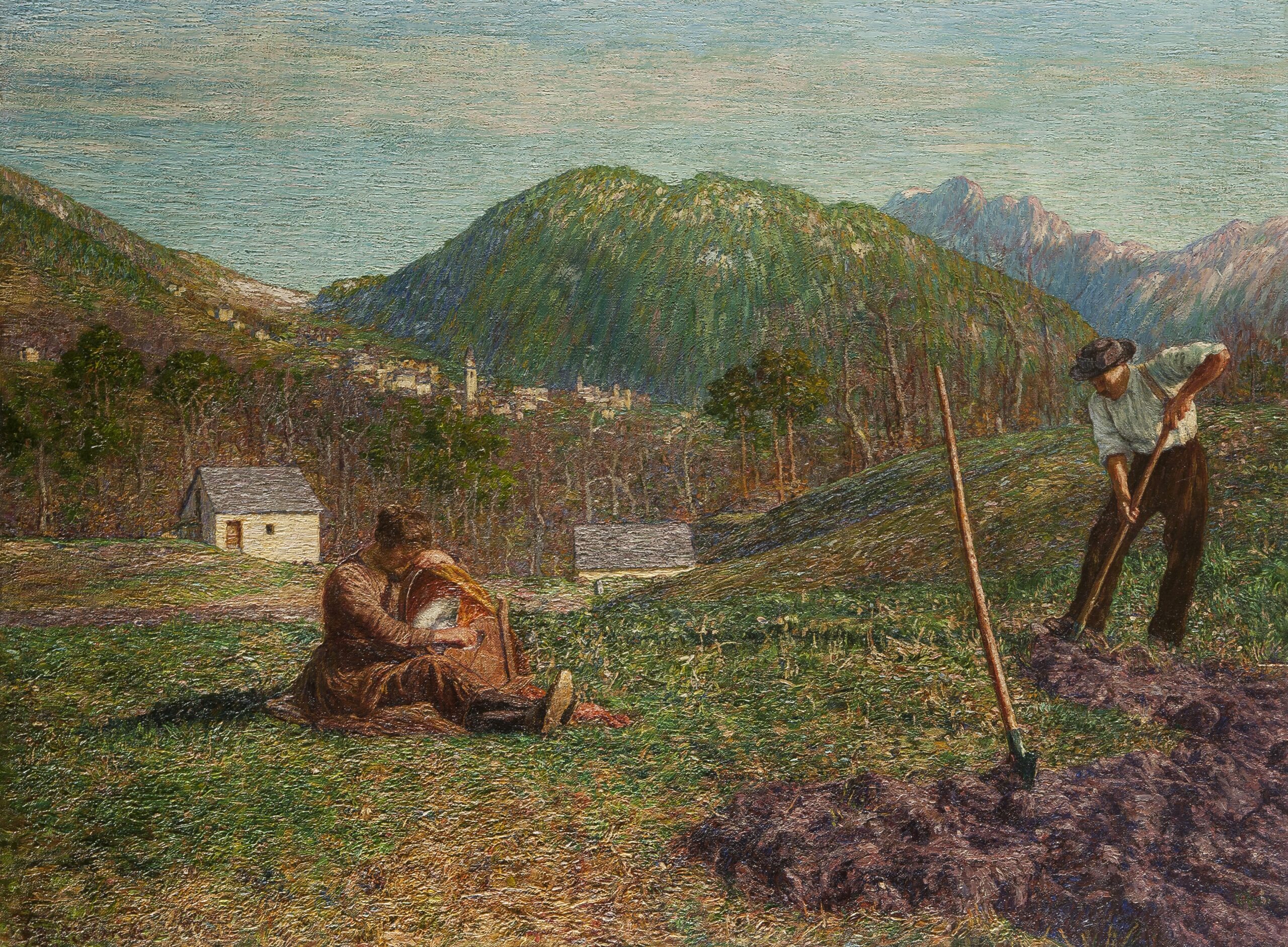Who are the real saints, the real heroes? We are the ones who succumb, martyrs of duty, silently struggling and tormenting ourselves in countless ways in life to achieve a noble purpose; the workers who toil from morning to night for a few coins in order to feed their families; those who are burdened by sufferings endured and repressed within themselves are also heroes and saints; they are the ones closest to God. The absolute faith of achieving what I have set out for myself will never, ever leave me. Nothing will have the power to divert me from my mission; I will throw myself into it completely, body and soul, overcoming whatever difficulties I might encounter. And so, I will fall and rise again until I have overturned the inevitability of fate and struck a powerful blow in the artistic field with a work of truth.
May 1896. Giovanni Battista Ciolina’s diaries. Transcribed by Paolo Ciolina


CRITICAL ANALYSIS
La raccolta delle patate (The Potato Harvest) is one of Ciolina’s works that has gained widespread recognition, along with Il filo spezzato (The Broken Thread), L’ombrellino rosso (The Red Parasol), La lavandaia (The Laundress), Mestizia Crepuscolare (Twilight Melancholy) and Il ritorno dall’Alpe (The Return from the Mountain). Its popularity is also attributed to its preservation at the Gian Giacomo Galletti Civic Museums in Domodossola.
Its substantial size, though not comparable to Il ritorno dall’Alpe, allowed the artist to create a monumental scene that embraces a large part of Toceno and the upper valley of the Eastern Melezzo, dominated by the Scheggia peak. The crisp light of a late autumn afternoon outlines the landscape with an almost unnatural clarity, casting a few long, sharp shadows on the emerald-green meadows, where the reds of the soil and the brown foliage of the few trees stand out.
The construction of the scene is skilful and balanced: the dark mass to the left of Mount Mater, reddened by the first autumn leaves and illuminated on the peaks by pristine patches of snow, contrasts with the group of three women with the basket laid down in the bottom right, defining an oblique line that is emphasised and highlighted by the gesture of the woman standing, wiping her moist forehead. This dominant diagonal is countered by the horizontal red masses of earth in the fore and background, the slightly inclined stretch of houses in Toceno, almost like a stage for the white, snow-covered mass of the Scheggia peak, and finally, the flat lines of yellow and pink cirrus clouds in the indigo sky. All of this transmits an overwhelming sense of peace, a fulfilment of the spirit, where the three women appear to perform a gesture that is naturally ancient and perfectly integrated.
The scene was obviously painted in a studio and is based on a photograph taken by the artist’s friend, Carlo Fornara, in which two of the three figures from the painting appear, namely the woman standing and the one bending on the ground behind her, who are clearly posed. However the photograph was taken in Prestinone, where the opening of the background landscape corresponds to that depicted in Ciolina’s painting and not the view seen from Toceno. Giovanni Battista employs the same method as Fornara, by composing and rearranging a series of real elements into a new whole. This is evident, for example, in the gesture of the woman standing, captured in the photograph with her left arm, but in the painting portrayed with her right. The two friends were no strangers to using photography in the composition of landscapes: Fornara used it extensively, and Ciolina had thus far used it mainly for Il ritorno dall’Alpe. (The Return from the Mountain). The dating of La raccolta delle patate to 1934 by Paolo, Ciolina’s son, is not reliable as it clashes with the fact that Ciolina had owned a camera for years and would not have needed to rely on Fornara. Besides, their friendship had broken down over two decades before and they would only reconnect shortly before Giovanni Battista’s death. It is therefore difficult to believe that the artist would reuse a photograph taken many years ago by his former friend, with the obvious aim of verifying a specific idea for a painting: namely, to compose a monumental scene, animated with figures that, among other things, recall those of the painter from Abruzzo, Francesco Paolo Michetti, with whom Fornara and Ciolina had direct contact in the last decade of the 19th century. Furthermore, it should be emphasized that the technique used for the painting is with well-defined, albeit small, brushstrokes, which have nothing in common with those used in Il ritorno dall’Alpe (dated to 1920), particularly for the sky. And above all, it is a technique that has little to do with the constructive brushstroke typical of many of Ciolina’s works, both from the 1940s and 1950s, as well as earlier ones like Toceno al tramonto (Toceno at Sunset – tappa 4). A dating to the first decade of the 20th century would be more appropriate.
The painting technique in Primavera in Valle Vigezzo, (Spring in the Vigezzo Valley), also from 1920, appears completely different compared to that of La raccolta delle patate. You don’t need to be an expert to notice that Primavera in Valle Vigezzo is constructed with a dense network of small specks of colour, with very fine brushstrokes that become slightly more pronounced only in the mass of the In Brun and Gridone mountains in the background. It is a composition that has often led to Ciolina being included in the group of divisionist painters, even though he rarely juxtaposed primary colours on his canvases, a prerequisite for the technique to be effectively divisionist.
What is certain is that in this work the principle of the optical fusion of colour (at the right distance) and the vibration of light are very evident and are clearly inspired by what the divisionist artists were doing, particularly Angelo Morbelli (who not surprisingly wanted to include Ciolina, along with Fornara, in the group). It should be added that in Primavera in Valle Vigezzo the figure of the ploughman bears a striking resemblance, in terms of clothing and pose, to some of the photographs taken by Fornara and later reused by Ciolina in I vangatori; (The Ploughmen). What is more, the figure and action of the mother with the cradle find a parallel in at least two works from the early 20th century by the artist from Prestinone, namely Vita nuova (New Life – 1900) and Ottobre sui monti (October in the Mountains – 1905).
It is therefore natural to conclude that Ciolina’s painting belongs to a period when he was more influenced by the Divisionist movement and so it should be significantly backdated, to the late 19th century or the early 1900s.
Text and image research and adaptation by Chiara Besana.
Critical analysis by Paolo Volorio.
Sign up to receive news on events, exhibitions and trainings from the Rossetti Valentini School of Fine Arts Foundation.
Iscriviti per ricevere le news su eventi, mostre, incontri di formazione organizzati dalla Fondazione Scuola di Belle Arti Rossetti Valentini.